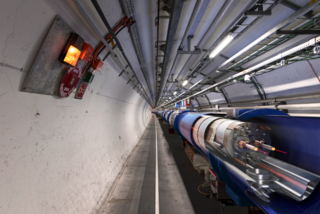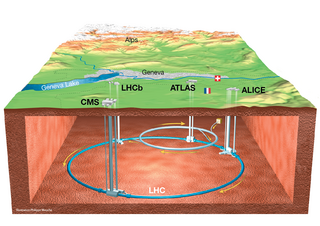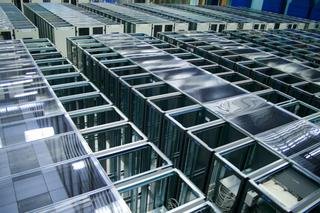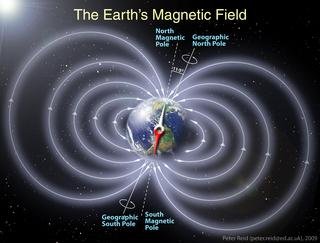Understanding the ‘how’ and ‘why’ behind the CERN Large Hadron Collider
I usually write a lot about the CERN LHC, as those who follow me know. I however rarely discuss the machine itself. In a recent post, I detailed the different steps of the LHC success story (see here).

[image credits: CERN]
I have nevertheless not yet described what is the LHC itself, and as you can guess, it is the topic of this post.
I will focus on the machine, the goals behind the building of such a huge accelerator (I recall this is the largest man-made experiment in the world) and how it actually works.
I will also try to motivate the gain for the particle physics community in having such a device operating today.
THE LARGE HADRON COLLIDER IN A FEW WORDS
The LHC is a machine built at CERN and located at the border between France and Switzerland. It is a ring long of 27 kilometers, buried at a depth varying from 45 meters to 170 meters.
Two beams of particles are accelerated in the ring, and then collided at four interaction points (see the picture below on the right).

[image credits: LHC@home]
The machine has been designed so that it can handle beams either of accelerated protons or of accelerated lead ions, so that three types of collisions can occur (proton-proton, proton-lead and lead-lead).
The size of the ring is such that the particles can be accelerated to energies that have never been reached so far. As a result, a new energy regime can be probed (in the aim to discover something).
Just to recall some special relativity, reaching high energy means in fact that we get options to produce massive new particles (Einstein told us that mass is energy).
MOTIVATIONS FOR THE LHC
As said above, one of the main motivation of the LHC is to have an experiment allowing us to reach high energies and discover new particles. But why are we confident some new phenomena can be found there? Actually, we are not.
The Standard Model of particle physics (the theory describing the world of the elementary particles) is known to contain a set of conceptual issues and limitations. In order to cure these ‘problems’, physicists have started to design more general theories.

[image credits: CMS]
Most of these theories predict the existence of new particles that are more massive than the Standard Model ones. And those new guys have still to be discovered, in particular at the LHC.
This machine is currently the best place for conducting the searches.
New particle discoveries are however not the single goal behind the building of the LHC. With the energy available, the LHC is actually a factory producing tons of particles of the Standard Model.
In this way, the properties of those particles (including the Higgs boson) will be scrutinized very deeply, and physicists will be able to look for deviations from the Standard Model.
That is a very good alternative fashion to search for new phenomena (and I recall that all options must be investigated, just to be sure not to miss anything).
HANDLING SO MANY COLLISIONS?
I said above that mass is roughly speaking energy, so that colliding particles at high energy means that we have a lot of energy to produce new massive particles. The mass-energy equivalence is however also true for the protons that we collide.
Therefore, in order to make them very energetic, there is only a single way: we need to accelerate them a lot. The proton mass being fixed, we need to get kinetic energy. In the LHC tunnel, protons are accelerated at 99.99999% of the speed of light before being smashed.
One single beam of protons contains about 2800 well-separated bunches of protons traveling into the LHC ring. The ring being 27 kilometers-long, this means that the speed of a bunch is of about 11000 turns per second.
This is equivalent to say that that at each interaction point, 40 millions of collisions occur at every second. The electronics of the detectors is then such that it is possible to sort out very quickly what is going on in a given collision, and record it if interesting.

[image credits: CERN]
The reason behind the fact that we cannot record everything is that we have a finite amount of disk space and time is needed to treat data. Out of the 40 millions of collisions happening every second, roughly 1000 of them can indeed be recorded.
We must thus rely on the electronics to decide what to record and what to ignore. And we know how to distinguish a boring collision from an interesting one. Most of the stuff ongoing is actually related to the production of low-energetic strongly-interacting particles, for which there is nothing new to learn.
IN PRACTICE
Particle colliders simply rely on electromagnetism. An electric field can be used to accelerate particles, and a magnetic field can be used to control their trajectories.

[image credits: NASA]
In the LHC framework, we are dealing with thousands of magnets that allow to keep the beam under control. The LHC magnets generate a magnetic field of 8.3 Tesla, that is more than 100.000 times the magnetic field of Earth.
This huge field allows one to keep the trajectory of the beams under a total control, both before and after the collisions.
Generating such a huge magnetic field is actually a big deal, and one needs to rely on huge electric currents to achieve this. The LHC magnets are fed with a current of 12000 Amperes, that is about 1000 times what we have in our homes.
This is why cryogenics is necessary: the LHC is cooled down to 1.9 Kelvin, that is cooler than what is found in space, and superconductivity can then be used.
SUMMARY AND REFERENCES
In this article, I tried to summarize the main motivations of high energy physicists in building the LHC. I have provided a few details on how the machine and its detectors work, that I hope are useful. These two respectively rely simply on electromagnetism, and on a powerful electronic system.
For more information, I recommend to have a look to on the CERN LHC website.
For more discussion on this topic (or anything related to science), please join us on #steemSTEM.
SteemSTEM is a community driven project which seeks to promote well written/informative Science Technology Engineering and Mathematics postings on Steemit. The project not only curates STEM posts on the platform through both voting and resteeming, but also re-distributes curation rewards as STEEM Power to members of Steemit's growing scientific/tech community. More information on our actions is available here. You can also follow our curation trail to support us (contact us on the chat for practical details). We thank you for your generous support.
Wow, that cleared up a lot of the questions I had about the machine. I had no idea it was supercooled and used magnets to accelerate the clusters, but it makes total sense. After the collisions and the data has been sifted and collected, is it just dumped on a community server which scientists can then run their experiments on? I'm assuming there is a large que of scientists waiting in line to get their opportunity to play with it for their experiments. Sounds like a wonderful time to be a physicist!
After a collision is selected for being recorded, it is send to servers at CERN and in different place in the world (the LHC computing network would deserve a post on its own). The experimenters analyze the data offline. There is no more experiment to run at this stage, but results to analyze. This leads to constraints on new phenomena (since no discovery so far) and a better understanding of the Standard Model.
Not all the high-energy physics community has access to all data. Taking CMS as an example, only CMS members can take care of the analyses (and this may take a very long time, and be updated with larger amount of recorded data). Data will come public in a later stage.
Thanks @lemouth for the clarification!
My pleasure :)
Good article.
I just heard somewhere that a bigger machine is being planned.
I have always thought that no matter the size or energy of a machine that we will keep finding smaller and smaller particles needing larger and larger machines.
I think it has something to do with the nature of the quantum world.
Because we believe there are smaller particles it is like the universe makes them for us to find.
A bigger machine is being discussed. This means, we are currently evaluating the physics potential of such a machine, how it should be, what the detector should look like, etc. The decision about its building or not should come in a year or so (hopefully).
We need larger machines to get to higher energy and get more massive particles (the size does not enter the equation here). And to get more energy, we need to accelerate more (and this is why the machine is larger).
There are models with smaller entities, but those are for the moment constrained by data (no observations). I have actually troubles in considering the existence of smaller entities as a consequence of the uncertainty principles in quantum mechanics.
Cool to 1.9 K? Its even cooler then liq helium! So they use physical method to cool the system?
They use a novel method to cool down superfluid liquid helium by means of both helium and nitrogen. The method was actually designed for this single purpose, and works in several stage to start from 80 K to 4.5 K and then to 1.9 K (with the phase transition to the superfluid state in the middle). Maybe can you be happy with this reference, as this is not really my field.
This is definitely amazing! I didn't realize the superfluid properties have such an important application!!!
btw I guess the liq nitrogen is just slow down the vaporization of liquid helium, as liquid helium is way way way more expensive then liquid nitrogen (This liq N2-He system was used in our NMR machine for the super magnet too :DD but 4 K is good enough for it)
Superfluidity is the only way for transporting such a large amount of current (the magnets are very hungry :p). Imagine the amount of copper cables that would be needed... It is actually not even imaginable.
Cables are still looks reasonable to me as they are not consumables. Yet, I was shock when i see they use tons scale of liq nitrogen 😂
The operating cost is definitely not imaginable!!!
The problem with the copper cable is the loss in electricity transport. That is why superconductivity was required.
The LHC is an incredible technical achievement - the only thing more impressive than the technical achievement is the fact that it was made at all. I don't think a pure science investment of that magnitude will happen in the United States for some time... perhaps ever again.
Yeah, the US money pie for science is getting smaller and smaller. I have heard (good) people have been fired by lack of money :(
Nice article.
I wonder when can we expect new collider that will let us achieve higher energies so we could get more massive particles, do you have any thoughts when it can happen?
This is not the correct question. Today, the question is in fact "if it will happen". The "when" is the next step. We are currently looking forward for news from Japan concerning a potential linear electron-positron collider. Normally, we will now next year (2018).
a very good post and I really like this post
Thanks!
Is this CERN LHC a kind of Particle accelerator, the kind depicted in the movie "Flash"? That kind that created "Meta-humans" when it exploded
The CERN LHC is an accelerator. Similar to what is in the Flash. But the comparison should stop there. Science and science -fiction are not the same ^^
I add my upvote to the chorus of well-deserved upvotes. There's a lot I didn't know about the LHC.
Thank you! Believe me, I could speak during hours about it ^^
Amazing informative post as always. Got to know many interesting information about LHC and how it works. Although, I have read about basic cyclotron in my physics class, but LHC is way more advanced.
As for many things in life, this is a matter of size ;)
Great post brothers..thanks
;)